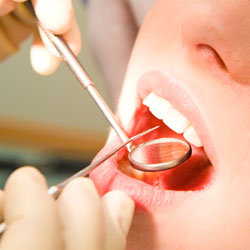Kenneth J. Canzoneri Blog
Protect Your Heart by Protecting Your Smile
July 8, 2011
 You know that daily brushing and flossing, plus regular dental visits, can help you prevent cavities. But did you also know taking care of your smile is important for your heart health, too?
You know that daily brushing and flossing, plus regular dental visits, can help you prevent cavities. But did you also know taking care of your smile is important for your heart health, too?
Without regular brushing or dental visits, bacteria and plaque can harden into tartar, which works with bacteria to create infected pockets between your teeth and gums. These pockets allow bacteria to enter your bloodstream and travel to other parts of your body, including your heart, where the cycle only continues.
Single-Visit Smile Makeovers from Your Arcadia Dentist
June 16, 2011
Almost everyone can pinpoint some aspect of their smile that they dislike. Maybe you have a dark spot on one tooth or yellow stains that age your appearance. Maybe you think that cosmetic dentistry is a luxury that only celebrities can afford. I’ve been practicing dentistry in the Arcadia area for over 25 years, and I’m here to tell you that almost everyone can benefit from a little conservative cosmetic dentistry. At our office, we even offer several procedures that can be completed in just one visit. (more…)
The Power Of A Smile
March 2, 2011
I cannot tell you how many times a patient or acquaintance has said to me “I really don’t care about the looks of my teeth, just fix the cavities.” Yet many of these people tend to hide their teeth by not smiling, looking away as they talk or putting their hand over their mouth.
There is nothing that adds more beauty to a face than a smile. Here are a few quotes about the value of a smile:
“A smile is a facelift that’s in everyone’s price range! “ Tom Wilson, American cartoonist.
“A smile is the light in your window that tells others that there is a caring, sharing, person inside.” Dennis Waitley, American writer.
Dale Carnegie, one of America’s great motivational speakers devotes an entire chapter in his book “How To Win Friends and Influence People” to the smile. He states “Actions speak louder than words and a smile says, I like you”
The importance of a youthful, healthy, bright smile cannot be overlooked or minimized. The first things people notice on a person’s face are the eyes followed by the mouth. Look in a mirror and smile. Is your smile saying I am a healthy, confident, youthful person or is your smile yellow and cracked or worn? Rejuvenating a smile is not a complicated, in many cases, as it would seem. Contact a dentist, check out some websites and see what is possible.
They say your eyes are the window to your soul , well I believe your smile is!
A Day at the Beach…
February 15, 2011

On Feb 4, 2011 Dr. Canzoneri and our team Deanna, Terry, Angela, Christina, Sandra, Valerie and Jacqueline spend the day together at the Hyatt, Huntington Beach.
What should you do if your tooth gets knocked out!
November 18, 2010
One of the biggest problems with saving a tooth that has been knocked out (the dental term is “avulsed”) is dealing with the chaos that ensues. People are all trying to give advice and there is usually a moderate amount of bleeding and pain with the trauma.
First save any tooth that has been knocked out and bring it to your dentist as soon as possible. The longer you wait the less chance the tooth can be reimplanted. Only handle the tooth by the crown (chewing edge). Try to replace the tooth in the socket. Make sure it is facing in the right direction. Do not try and force it into the socket. If it doesn’t go back into place easily, then it’s better to bring it to your dentist. Place the tooth in a container and cover it with milk or saliva. The tooth can also be carried between the lower lip and gum or under the tongue.
Once a tooth has been reimplanted a dentist will usually stabilize it by attaching it to the teeth next to it. Usually a root canal will need to be done because the nerves and blood vessels in the tooth are damaged beyond repair.
If you are faced with this sort of trauma, remember to stay calm, follow these few steps and your chance to save your tooth will increase.
Are You A Candidate For Implants?
October 25, 2010
Are you missing a permanent tooth? Do you have gaps in your smile? Do your dentures slip or click while talking and eating? You may be a candidate for dental implants.
A dental implant is an artificial tooth root that a dentist places into your jaw to hold a replacement tooth, bridge or denture, rather than anchoring it to a healthy neighboring tooth.
Dental implants take several steps but usually a patient will be able to continue their regular professional and social activities. Teeth which are supported by implants might as well be you own; they look natural, are comfortable and withstand the rigors of grinding and chewing.
Unfortunately, dental implants are not for everyone. Your present dental health will influence whether you are a good candidate for a dental implant. Some medical conditions possibly could interfere with normal healing, such as diabetes or heart problems. Other conditions which may prevent using implants are poor supporting bone in your jaw, clenching or grinding your teeth and smoking.
Toothbrush Handles…Does It Matter?
August 24, 2010
I have received a great deal of feedback regarding my last article about toothbrushes. Many readers have requested more information concerning toothbrush selection.
I believe one of the most overlooked parts of the toothbrush is the handle. Believe it or not a great deal of research goes into the design of a toothbrush handle.
Straight handle: This handle usually accompanies a brush with a flat edge. This design acts to decrease pain in the gums when brushing.
Bent handle: Typically the end of the brush is wavy. This allows you to reach around turns in the month. It is especially helpful reaching around the back of second molars.
Handles with ridges: These are very important handles. They allow people who have a hard time holding a toothbrush to get a little better grip. People with big or little hands, weak hand muscles or anyone with a reduced hand / muscle function can benefit from this handle.
Handles with cute characters on them: Children’s toothbrush handles usually have alligators or cartoon characters on them. This serves two purposes, its fun to brush with them and it gives a child’s small, inexperienced hands something to grip.
Most importantly remember that no matter which toothbrush you select it will only be helpful if you brush three times a day for a minimum of 2 minutes and don’t forget to floss.
How Select A Toothbrush
Although I have a strong opinion on toothbrushes, I have to admit that I bought a new fancy toothbrush the other day. It had “space age” plastic components to the bristles that were supposed to massage the gums. Did I mention it has blue, yellow and clear bristles! I used this rainbow colored toothbrush for two days before throwing it away! The average American spends nearly 1,000 hours brushing their teeth over a lifetime. Finding the right toothbrush is very important. I am a strong advocate of a soft bristle or feather. I know many of you feel that it does not clean your teeth. But research shows it is a very efficient bristle and unlike harder bristles, it does not irritate your gums. The handles of toothbrushes are either straight, bent or round. Although all these handles have different purposes, the best way to select a toothbrush handle is buy the one which fits best in your hand. In reality, most of the modern, soft bristle brushes work well. What is most important is knowing how to brush correctly and brushing for at least two to three minutes. Select a toothbrush head size that can easily fit into the mouth and can brush one to two teeth at a time.
Fluoride is it necessary?
June 24, 2010
I think fluoride is an important part of having healthy teeth. Fluoride is a mineral that is naturally present in almost all foods, water supplies and many dental products such as toothpaste and certain mouth rinses. The American Dental Association, The World Health Organization and the American Medical Association have endorsed the use of fluoride in water supplies. Multiple studies have shown that when fluoride is added to a water supply, tooth decay decreases, fluoride acts in two ways: topically and systemically. Topical fluorides strengthen teeth that are already erupted in the mouth. The fluoride is absorbed into the outer surface of the tooth, making it more resistant to decay. Systemic fluorides are ingested through food and water and are used by teeth which are developing. Children between 6months and 16 years can benefit from fluoride.
This is important, too much fluoride can cause a condition called fluorosis. Dental fluorosis is caused by a child receiving too much fluoride during tooth development. The critical period is between 1 and 4 years old. Children over age 8 are not at risk.
How To Keep a Healthy Smile
June 9, 2010
It is very common for people to neglect their teeth. I have found that quite often when a person has no pain in their mouth and decent looking teeth that they assume heir teeth are in good shape. These are usually the people who have underlying gum disease and undiagnosed decay. In order to keep your smile healthy and teeth bright pay attention to your teeth and gums. If you are pregnant higher levels of hormones can cause puffy, tender gums that can increase the risk of gum infection. Grinding and or clenching your teeth can lead to severe wear, cracking and chipping of tooth structure. Many medications can cause dry mouth, which increases your risk of tooth decay. Drinking lots of water, chewing sugarless gum and using a fluoride rinse at night can help protect your teeth against reduced saliva. I have discussed the dangers of smoking but I will mention it again. Smokers are two to three times more likely to get periodontal disease. I wont even go into what smoking can do to the color of your teeth. Sitting in a dental chair isn’t anybody’s favorite thing to do but if you go for regular dental check-ups you will learn how to keep your smile healthy!
